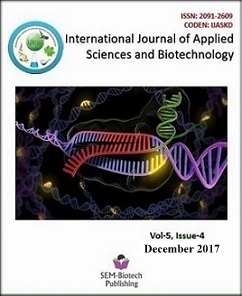Response of Maize to the Soil Application of Nitrogen and Phosphorous Fertilizers
DOI:
https://doi.org/10.3126/ijasbt.v5i4.18777Keywords:
Maize, N, P, Split application, Grain yieldAbstract
Poor nutrient management is one of the key factors contributing to decline in the productivity of maize in Nepal. Few studies have been done on developing site and variety specific fertilizer recommendation. Therefore, a field experiment was conducted at National Maize Research Program (NMRP) Rampur, Chitwan during winter season in September 2016 to study the response of hybrid maize (RML95/RML96) to different doses of soil application of nitrogen (N) and phosphorous (P). The treatments included were 120:60, 120 :( 40+20), 160:60, 160 :( 40+20), 200:60, 200 :( 40+20), 240:60, and 240 :( 40+20) N: P kg ha-1. Potassium fertilizer was fixed and applied as per the Government recommendation i.e., 40 kg K ha-1.Eight treatments were replicated three times in randomized complete block design and maize was planted in six rows of four meter long plot. The research findings revealed that each level of N significantly increased grain yield up to 240 kg N ha-1. The grain yield (8.8 t ha-1) obtained under 240 kg N ha-1 was significantly higher than that obtained under 120,160 and 200 kg N ha-1. However, the results revealed that split application of P failed to bring about any significant difference in the grain yield as well as yield parameters of maize. We can, thus conclude that the addition of increasing rate of N increases the yield and yield attributing characters of maize.
Int. J. Appl. Sci. Biotechnol. Vol 5(4): 537-541




